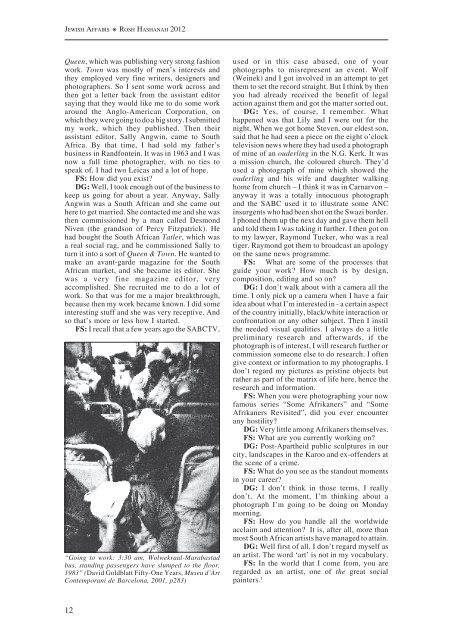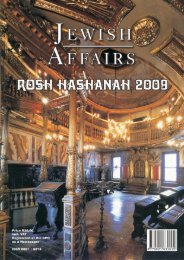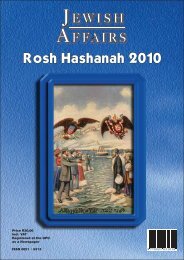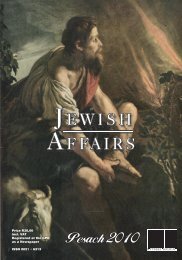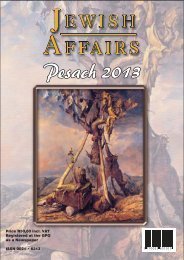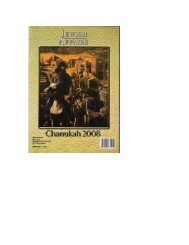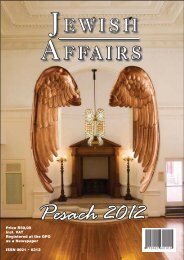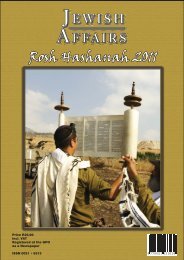Jewish Affairs - South African Jewish Board of Deputies
Jewish Affairs - South African Jewish Board of Deputies
Jewish Affairs - South African Jewish Board of Deputies
- No tags were found...
Create successful ePaper yourself
Turn your PDF publications into a flip-book with our unique Google optimized e-Paper software.
JEWISH AFFAIRS ROSH HASHANAH 2012Queen, which was publishing very strong fashionwork. Town was mostly <strong>of</strong> men’s interests andthey employed very fine writers, designers andphotographers. So I sent some work across andthen got a letter back from the assistant editorsaying that they would like me to do some workaround the Anglo-American Corporation, onwhich they were going to do a big story. I submittedmy work, which they published. Then theirassistant editor, Sally Angwin, came to <strong>South</strong>Africa. By that time, I had sold my father’sbusiness in Randfontein. It was in 1963 and I wasnow a full time photographer, with no ties tospeak <strong>of</strong>. I had two Leicas and a lot <strong>of</strong> hope.FS: How did you exist?DG: Well, I took enough out <strong>of</strong> the business tokeep us going for about a year. Anyway, SallyAngwin was a <strong>South</strong> <strong>African</strong> and she came outhere to get married. She contacted me and she wasthen commissioned by a man called DesmondNiven (the grandson <strong>of</strong> Percy Fitzpatrick). Hehad bought the <strong>South</strong> <strong>African</strong> Tatler, which wasa real social rag, and he commissioned Sally toturn it into a sort <strong>of</strong> Queen & Town. He wanted tomake an avant-garde magazine for the <strong>South</strong><strong>African</strong> market, and she became its editor. Shewas a very fine magazine editor, veryaccomplished. She recruited me to do a lot <strong>of</strong>work. So that was for me a major breakthrough,because then my work became known. I did someinteresting stuff and she was very receptive. Andso that’s more or less how I started.FS: I recall that a few years ago the SABCTV,“Going to work: 3:30 am, Wolwekraal-Marabastadbus, standing passengers have slumped to the floor,1983” (David Goldblatt Fifty-One Years, Museu d’ArtContemporani de Barcelona, 2001, p283)used or in this case abused, one <strong>of</strong> yourphotographs to misrepresent an event. Wolf(Weinek) and I got involved in an attempt to getthem to set the record straight. But I think by thenyou had already received the benefit <strong>of</strong> legalaction against them and got the matter sorted out.DG: Yes, <strong>of</strong> course, I remember. Whathappened was that Lily and I were out for thenight. When we got home Steven, our eldest son,said that he had seen a piece on the eight o’clocktelevision news where they had used a photograph<strong>of</strong> mine <strong>of</strong> an ouderling in the N.G. Kerk. It wasa mission church, the coloured church. They’dused a photograph <strong>of</strong> mine which showed theouderling and his wife and daughter walkinghome from church – I think it was in Carnarvon –anyway it was a totally innocuous photographand the SABC used it to illustrate some ANCinsurgents who had been shot on the Swazi border.I phoned them up the next day and gave them helland told them I was taking it further. I then got onto my lawyer, Raymond Tucker, who was a realtiger. Raymond got them to broadcast an apologyon the same news programme.FS: What are some <strong>of</strong> the processes thatguide your work? How much is by design,composition, editing and so on?DG: I don’t walk about with a camera all thetime. I only pick up a camera when I have a fairidea about what I’m interested in - a certain aspect<strong>of</strong> the country initially, black/white interaction orconfrontation or any other subject. Then I instilthe needed visual qualities. I always do a littlepreliminary research and afterwards, if thephotograph is <strong>of</strong> interest, I will research further orcommission someone else to do research. I <strong>of</strong>tengive context or information to my photographs. Idon’t regard my pictures as pristine objects butrather as part <strong>of</strong> the matrix <strong>of</strong> life here, hence theresearch and information.FS: When you were photographing your nowfamous series “Some Afrikaners” and “SomeAfrikaners Revisited”, did you ever encounterany hostility?DG: Very little among Afrikaners themselves.FS: What are you currently working on?DG: Post-Apartheid public sculptures in ourcity, landscapes in the Karoo and ex-<strong>of</strong>fenders atthe scene <strong>of</strong> a crime.FS: What do you see as the standout momentsin your career?DG: I don’t think in those terms, I reallydon’t. At the moment, I’m thinking about aphotograph I’m going to be doing on Mondaymorning.FS: How do you handle all the worldwideacclaim and attention? It is, after all, more thanmost <strong>South</strong> <strong>African</strong> artists have managed to attain.DG: Well first <strong>of</strong> all, I don’t regard myself asan artist. The word ‘art’ is not in my vocabulary.FS: In the world that I come from, you areregarded as an artist, one <strong>of</strong> the great socialpainters. 112


